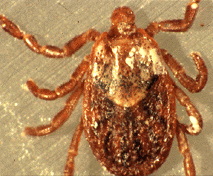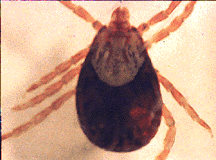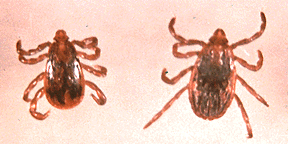Family Ixodidae (Hard Ticks)
Dermacentor albipictus (the winter tick)

This one host tick is found throughout North America. It is widely distributed throughout California, but populations are concentrated around the central coastal and sierra foothill areas. It primarily feeds on horses and deer from fall through early spring. Heavy infestations of horses may cause emaciation and anemia (Furman and Loomis 1984). After hatching from the egg, larvae attach to a host, feed and detach, remaining on the animal. Subsequently, they molt to the nymphal stage, resume feeding and detach again. After they develop into adults and feed once again, they drop to the ground and lay their eggs, where the cycle begins once again.
Dermacentor occidentalis (Pacific Coast Tick)

The Pacific Coast Tick is a three host tick which commonly feeds on rodents, especially squirrels, as subadults, and on cattle, horses, deer, and humans as adults. This is one of the most widely distributed ticks in California. It is found throughout the state except for the very dry regions of the central valley and the southeastern desert region.The only other areas it has been collected in are Oregon and Baja, Mexico (Furman and Loomis 1984).
Dermacentor andersoni (Rocky Mountain Wood Tick)

The Rocky Mountain wood tick is a three host tick which as a subadult primarily feeds on small rodents; as adults they focus on large mammals, especially deer, humans, canids, and livestock. This tick is well known as a vector of the Rocky Mountain spotted fever rickettsia in the northwestern U.S. and Canada, the Colorado tick fever virus, and the bacteria which causes tularemia (hunter’s disease). It is also commonly responsible for tick paralysis in humans, livestock, and wild mammals (Furman and Loomis 1984). However, in California, this tick poses little threat to human and animal health because of its scanty distribution in less populated areas of the state. It has been collected primarily in the upper eastern part of the state, from Modoc county down to the eastern range of the northern Sierras.`
Dermacentor variabilis (American Dog Tick)

The American dog tick is a three host tick that feeds on rodents and lagomorphs during its subadult life stages, and large mammals, frequently canids and humans, as adults. It is the most important vector of the Rocky Mountain spotted fever rickettsia in the eastern U.S. and is also able to transmit the bacteria which causes tularemia (hunter’s disease). It has also been found responsible for tick paralysis in some states. This tick is widespread throughout the U.S. as well as parts of Canada and Mexico. In California, it is most frequently found along the coastal ranges down the length of the state, but has also been collected in the central valley and along the eastern Sierra range (Furman and Loomis 1984).
Ixodes pacificus (Western Black Legged Tick)

The Western black legged tick is a three host tick that primarily feeds on lizards and small rodents during its subadult life stages, and large mammals, commonly deer, canids, horses, and humans, as adults. It is the putative vector of the Lyme disease spirochete and the equine granulocytic ehrlichiosis rickettsia in California. This tick is found in the western U.S. and British Columbia. In California, its distribution appears to be limited to the moister regions of the coastal and Sierra foothill ranges all along the state (Furman and Loomis 1984). Humans bitten by these ticks may notice intense inflammation at the site of the bite which may be slow to heal. These sores do not necessarily indicate pathogen transmission by the tick (ie: Lyme disease “bulls eye” rash), but are frequently an artifact of irritation due to tick salivary products injected into the bite site.
Rhipicephalus sanguineus (Brown Dog Tick)

The brown dog tick, or kennel tick, is a three host tick that is an important pest of dogs in the U.S., especially those housed in kennels. It feeds on dogs during all three life stages, but drops off and reattaches during each stage. This tick is the only representative of its genus in the U.S.; its cosmopolitan distribution includes temperate to tropical regions. Outside the U.S., this tick commonly infests a variety of domestic and wild mammals besides dogs. Unlike most other hard ticks, eggs of this tick are laid inside or near housing areas of animals, in cracks and crevices, rather than outside, on the ground under vegetation. This tick is the putative vector of the canine ehrlichiosis rickettsia and the canine babesiosis protozoa in the U.S. as well as a variety of other rickettsia worldwide. In California, this tick has been collected almost exclusively from dog kennels scattered across the state; it is probably found in most parts of the state where dogs reside (Furman and Loomis 1984).
References
D.P. Furman and E.C. Loomis. 1984. The Ticks of California. University of California Publications, Bulletin of the California Insect Survey, Vol. 25. University of California Press, California.
D.E. Sonenshine. 1991. Biology of Ticks, Vol. 1. Oxford University Press, New York.
D.E. Sonenshine. 1993. Biology of Ticks, Vol. 2. Oxford University Press, New York.
